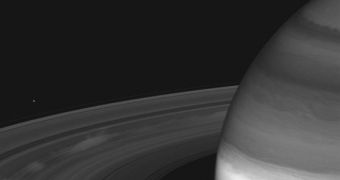On September 22, 2009, around the time Saturn experienced its once-in-15-years equinox, the Cassini spacecraft imaged peculiar, cloud-like formations hovering above the gas giant's famous rings. The bright clouds contained luminous ice particles, a detailed analysis of the photographs revealed. During the equinox, the rings were hit by sunlight edge-on, with most light falling perpendicular to the Saturnine equator. Previously undetected features in the ring were discovered in a series of amazing images that Cassini, a joint NASA / ESA (European Space Agency) probe, snapped at the time.
Because of the unique lighting geometry of the equinox period, the icy formations, more commonly known as “spokes,” were seen in great detail. Each of the formations can grow to be about 10,000 kilometers, or some 6,000 miles, wide and the particles inside are able to essentially levitate above the rings because they acquire an electrical charge. They appear to be separated from the rings in the dramatic, new photographs, because sunlight accentuates the space between the two formations, experts at the NASA Jet Propulsion Laboratory report. The JPL is managed by the space agency, but it's located at the California Institute of Technology (Caltech), in Pasadena, California.
The electrostatic charge that creates the spokes is, in essence, the same phenomenon that sees the hair on your hands rising up when brought close to an electrically charged object. During dim conditions, it would appear that the structures gain more strength, the experts explain. Another reason why they were so clearly visible in the images was the fact that light hit the rings at the correct angle. This only makes sense when considering that, for all their width, the circular formations are extremely thin. When light passes directly through them, features that normally stay concealed are revealed to Cassini's cameras.
Using this knowledge, the probe's mission controllers were able to identify new moons and moonlets around the planet, and also to determine that the rings did not have a smooth surface. Variations that have a mountain-like appearance can grow to be up to ten kilometers (six miles) high, something that was previously unknown. Cassini captured the new images from its vantage point some 1.3 million kilometers (808,000 miles) away from the gas giant's surface, by using its wide-angle camera. Most spokes were identified on the planet's B Ring. The spacecraft also caught the moon Janus in the image, pictured as a bright dot to the left of it.

 14 DAY TRIAL //
14 DAY TRIAL //